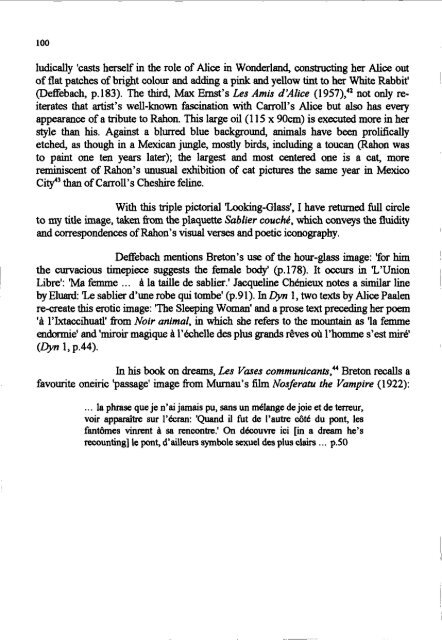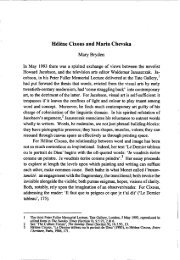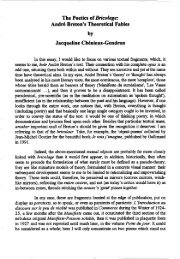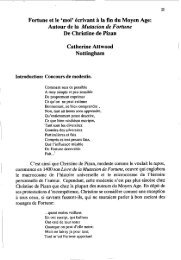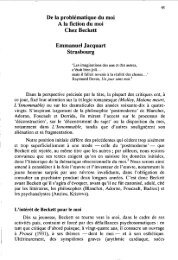Through An Hour-giass Lightly: Valentine Penrose and Alice Rahon ...
Through An Hour-giass Lightly: Valentine Penrose and Alice Rahon ...
Through An Hour-giass Lightly: Valentine Penrose and Alice Rahon ...
Create successful ePaper yourself
Turn your PDF publications into a flip-book with our unique Google optimized e-Paper software.
1<br />
I<br />
100<br />
ludically 'casts herself in the role of <strong>Alice</strong> in Wonderl<strong>and</strong>, constructing her <strong>Alice</strong> out<br />
of flat patches of bright colour <strong>and</strong> adding a pink <strong>and</strong> yeliow tint to her White Rabbit'<br />
(Deffebach, p.183). The third, Max Emst's Les Amis d'Alite (1957);' not oniy reiterates<br />
that artist's well-known fascination with Carroll's <strong>Alice</strong> but also has every<br />
appearance of a tribute to <strong>Rahon</strong>. This large oil (1 15 x 9Ocm) is executed more in her<br />
style than his. Against a blurred blue background, animais have been proiiñcaily<br />
etched, as though in a Mexican jungle, mostiy birds, including a toucan (<strong>Rahon</strong> was<br />
to paint one ten years later); the largest <strong>and</strong> most centered one is a cat, more<br />
reminiscent of <strong>Rahon</strong>'s unusual exhibition of cat pictures the same year in Mexico<br />
Cis3 than of Carroli's Cheshire feline.<br />
With this íriple pictorial Zooking-Glass', I have returned full circle<br />
to my titie image, taken h m the plaquette Sablier couché, which conveys the fluidity<br />
<strong>and</strong> correspondences of <strong>Rahon</strong>'s visual verses <strong>and</strong> poetic iconography.<br />
Deffebach mentions Breton's use of the hour-glass image: 'for him<br />
the curvacious timepiece suggests the female body' (p.178). It occu~s in 'L'Union<br />
Libre': !Ma femme ... à la taiile de sablier.' Jacqueline Chénieux notes a simiiar line<br />
by Eluard: 'Le sablier d'une robe qui tombe' (p.91). In Qw 1, two texts by <strong>Alice</strong> Paalen<br />
re-create this erotic image: 'The Sleeping Woman' <strong>and</strong> a prose text preceding her poem<br />
'à 1'Ixtaccihuatl' fiom Noir animal, in which she refm to the mountain as 'la femme<br />
endormie' <strong>and</strong> 'miroir magique à l'échelle des plus gr<strong>and</strong>s rêves où l'homme s'est miré'<br />
(9.1 1, P.44).<br />
In his book on dreams, Les Vases communicantqU Breton recalls a<br />
favourite oneiric 'passage' image fiom Murnau's ñlm Nosferatu the Vampire (1922):<br />
. . . la phrase que je n'ai jamais pu, sans un mélange de joie et de terreur,<br />
voir apparaîîre sur l'écran: 'Qu<strong>and</strong> ii fut de l'autre côîé du pont, les<br />
fantômes vinrent à sa rencontre.' On découvre ici [in a dream he's<br />
recounting] le pont, d' deurs symbole sexuel des plus clairs . . . p. 50


